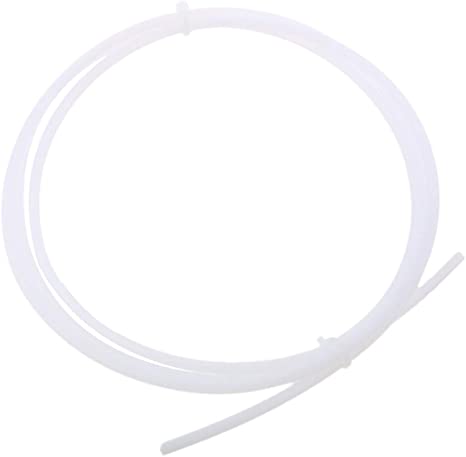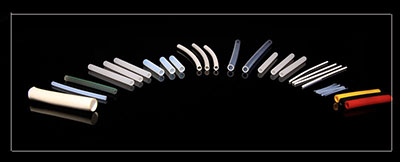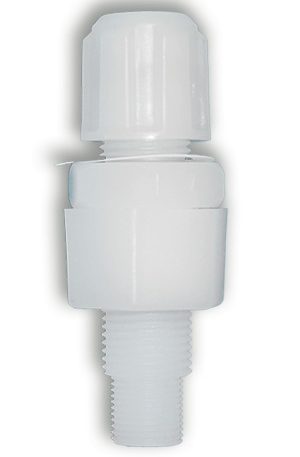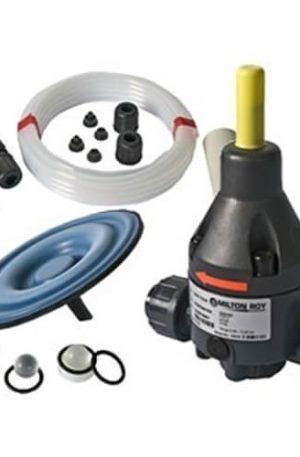Description
PTFE Tube in Pakistan
PTFE Tubing (PolyTetraFluoroEthylene tubing) is a semi-transparent, chemically inert, and non-toxic material that features unmatched temperature resistance and a surface that facilitates the flow of fluids. PTFE tubes are used for applications requiring resistance to high temperatures, corrosive chemicals, and high voltages.
Before you leave contact us for a good price of PTFE Tube
PTFE Tube in Pakistan
As such, it finds use in fluid transfer applications, cabling, and heat-exchanger systems.
PTFE can be used in service temperatures of up to 260°C, making it a material of choice in high temperature applications. It also has a breakdown voltage of up to 100Kv/mm, making it ideal in electrical insulation
PTFE Tube in Pakistan
FluoroTube marks the entry of Poly Fluoro Ltd. into the PTFE (PolyTetraFluoroEthylene) tubing segment. We manufacture various grades and sizes of tubes, making FluoroTube ideal for medical, chemical, and automotive applications.
PTFE Tube includes:
- Spaghetti tubing – with a wall thickness of within 1.5mm and an outer diameter of less than 15mm, this tubing is used extensively in both medical and automotive applications.
- PTFE hoses – these are heavy-wall thickness tubes and are used primarily in applications that need high-burst pressures or heavy insulation.
-
PTFE Tube in Pakistan
- PTFE sleeves – these can be either extruded or compression-molded. Their wall thickness is usually between 2-6mm, but the diameter could go up to as much as 300mm. Sleeves are used in a variety of applications that need insulation, lubrication, corrosion resistance, or load bearing.
| Properties | Benefits |
|---|---|
| High chemical resistance | Suitable for carrying highly corrosive/reactive fluids |
| Distinctly inert | Extensively useful in medical applications |
| Withstands temperatures of up to 240°C | Effective in high-heat applications |
| Superior dielectric strength | Insulating medium in cables and heavy electricals |
PTFE tube – one product, numerous applications
The evolution of Polytetrafluoroethylene (PTFE) – more commonly known as Teflon® – from a niche product used only in high-value applications to a mainstream requirement has been very gradual.
However, over the past two decades PTFE usage seems to have crossed a critical mass, allowing it to become commercially viable in over 200 industrial, consumer and medical applications. And while sheets, rods, coatings and components corner the bulk of the market for PTFE products, PTFE tubing is now emerging as the key growth area.
PTFE tube Applications
The use of PTFE tube has spread across various applications including automotive, chemical, electrical and medical. Table 1 shows the key properties which outline the versatility of PTFE tubing, while Fig 1 shows its uses in various fields.
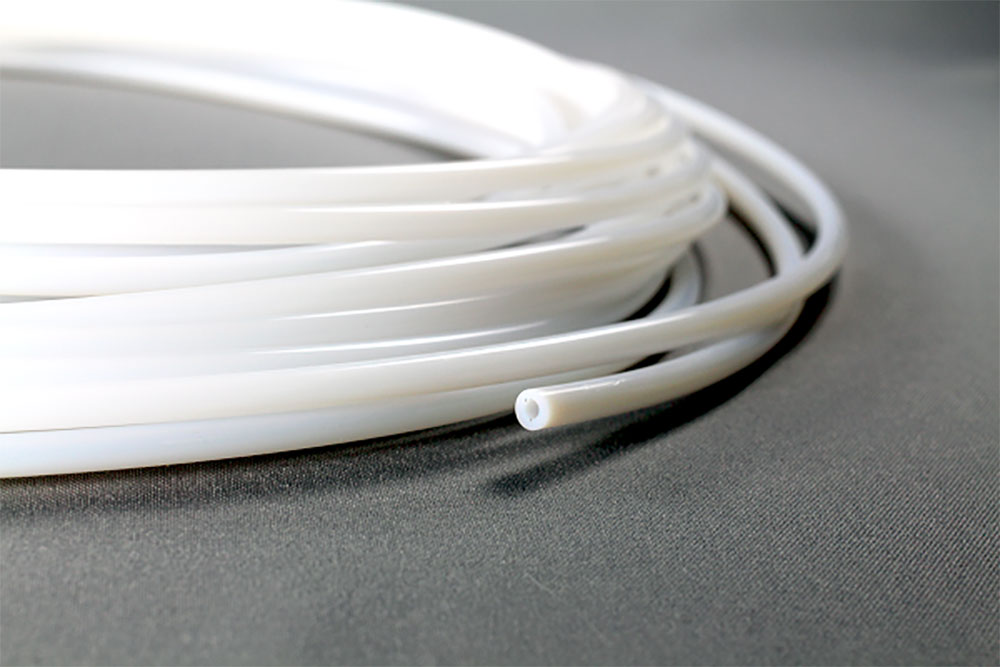
PTFE Tube in Pakistan
- In automotive applications, the ability of PTFE to withstand temperatures in excess of 250oC makes it an ideal candidate for high temperature fluid transfer.
- In medical applications, PTFE tubing is in huge demand due to its lubricity and chemical inertness. Catheters employing PTFE tubing can be inserted into the human body without fear of reaction or abrasion with any body parts.
- In chemical applications – including laboratories – PTFE is an ideal replacement for glass due to its inertness and durability.
- In electrical applications, the excellent dielectric properties of virgin PTFE make it well suited for insulating high voltage cables.
| Property | Comments | Applications |
| Heat resistance |
|
|
|
Dielectric strength |
|
|
|
Low friction |
|
|
|
Corrosion resistance |
|
|
Table 1: Key properties and applications of PTFE tubing
Types of PTFE tubing
Depending on the application, PTFE tubing is divided into three broad categories – each defined by the tube’s diameter and the wall thickness (see Table 2).
| Diameter (mm) | Wall thickness (mm) | |
| Spaghetti tubing | 0.2-8 | 0.1-0.5 |
| Pressure hose | 6-50 | 1-2 |
| Pipe Liner | 12-500 | 2-8 |
Table 2: Categories of PTFE tubing
PTFE Tube in Pakistan
Even within categories, PTFE tubing lends itself to different variations, each allowing for a different application (see Table 3):
| Type | Description | Purpose |
|
Multi-lumen |
Single outer tube with multiple inner tubes |
Each inner tube holds a different fluid/ wire – useful in medical applications |
|
Split |
Ridge on tube wall allowing it to be split longitudinally |
Surgeon can remove a PTFE introducer from a patient while the primary device remains in place |
|
Corrugated/ convoluted |
Folds on outer wall |
Gives higher bend-ability, reducing risk of kinks when tube is passed through tight angles |
| Heat shrinkable | Thin tubing which shrinks in diameter when hot air is applied to it | Used to sheath wires, glass tubes for insulation or protection |
|
Filled |
Chemical additive giving radiopaque properties | Used in medical inserts – to show up in X-rays |
Table 3: Variants of PTFE tubing
PTFE tubing in the medical device market
In general, small diameter spaghetti tubing is used in medical applications. The use of PTFE in this area centres on two key properties: lubricity and biocompatibility. Fluoropolymers exhibit very good lubricity compared with other plastics. PTFE is the most lubricious polymer available, with a coefficient of friction of 0.1, followed by fluorinated ethylene propylene (FEP), with 0.2. These two polymers represent the vast majority of all fluoropolymer tubing used in medical devices.
The biocompatibility of any polymer used in a medical device is an obvious concern. PTFE excels in this area and has a long history of in vivo use. Medical-grade fluoropolymers should meet USP Class VI and ISO 10993 testing requirements. Of course, processing cleanliness is also an important factor.
PTFE tube – processing techniques
The uniqueness of PTFE tubing rests in the complexity of PTFE as a polymer. While most polymers lend themselves easily to injection moulding – allowing them to be made into complex shapes, PTFE due to its high melting point and melt viscosity can only be compression moulded. The high melting point of PTFE also means that extrusion – as conventionally practiced – cannot be applied to it. PTFE paste extrusion has therefore become a process which is increasingly sought after – given the growing demand for PTFE tubing.
PTFE Tube in Pakistan
Extruded grades of PTFE were first used in the wire and cable industry in the 1950s, where the good dielectric properties of the material proved critical to the developing electronics market. The first tubing was made by extruding PTFE over a wire and then removing it-a labour-intensive process. In the 1960s, technology emerged that could perform the extrusion of PTFE without a wire core. This process enables PTFE tubing to be economically produced in long continuous lengths.
PTFE Tube in Pakistan
PTFE paste extrusion follows 6 broad steps as illustrated below:
- Mixing: The resin comes in a powder form with an average particle size of about 0.2µm. The powder is waxy and prone to bruising and mechanical shear fibrillation. Hence handling must be careful and done typically at a temperature of around 20°C. While standard compression moulding only requires that the powder be sieved thoroughly and then compressed, in paste extrusion the powder must be first mixed with a hydrocarbon extrusion aid or mineral spirits. The powder-spirit mixture is left in a sealed container before it is used in the next process.
-
PTFE Tube in Pakistan
- Pre-form: The pre-form is a billet made by compressing the mixture in a hydraulic press. A standard 30Kg billet would take approximately 2 hours to mould, following which a dwell time is necessary to ensure any excess air pockets get released
- Extruding: the pre-form is loaded into the extruder – the key equipment in the process – and a die and mandrel are clamped in place above it. The die is a critical tool and its design defines the strength of the tube and its final dimensions. As the extrusion process starts, the extruder presses the pre-form against the die and mandrel, forcing the resin to extrude into the desired shape. The tubing in this stage is referred to as ‘green’ and can be easily crushed.
-
PTFE Tube in Pakistan
- Pre-sintering: the green tubing is passed through an oven where it is heated at a very low temperature. The idea here is to evaporate the spirit in the tube and care must be taken so that the flash point of the spirit is not reached, causing it to ignite.
- Sintering: the PTFE tubing is sintered at 350-400°C. The sinter cycle will depend on the thickness of the tubing and can last up to 24 hours for thick walled tubing
- Cleaning and packaging: the tube is first cut into he desired lengths. In the case of medical tubing, the ends of the tube must be plugged as soon as the material comes out of the oven. The plugging ensures that the inside of the tubing – which has seen temperatures well in excess of 300°C – remains clean. For further cleaning an ISO Grade VI clean room is the minimum requirement for PTFE tubing. After the cleaning the tubes are packed in polythene covers for dispatch.
PTFE Tube in Pakistan

Fig 1: Typical extrusion die
PTFE Tube and Poly Fluoro Ltd. – FluoroTube™
Poly Fluoro Ltd. was established in 1985 – at a time when India was not yet fully aware of the properties of PTFE or its usefulness across so many industries.
The company has built its expertise in mainly industrial applications – making machine components, slideway bearing materials (Turcite/Lubring) and PTFE tapes – and become a reputable player in the industry.
PTFE Tube in Pakistan
More recently, Poly Fluoro Ltd. has embarked on a plan to strengthen its presence in medical applications. With this in mind, the company has invested heavily in developing laboratory wares, PTFE coated guidewires (used extensively in urology) and PTFE tubing.
FluoroTube™ marks the entry of Poly Fluoro Ltd. into the PTFE tubing segment. With this product, Poly Fluoro is looking to build a tubing brand, which assures the client the highest quality of PTFE tubing.
PTFE Tube in Pakistan
FluoroTube™ will also be the first PTFE tubing manufactured in India – giving the local market
PTFE tubing at a price point that would greatly improve their cost dynamics and allowing the full demand for PTFE tubing to be met in Pakistan.
PTFE Tube in Pakistan
The grades and sizes available make FluoroTube™ ideal for applications such as medical, chemical and automotives.
FluoroTube™ comes in sizes ranging from 1mm to 25mm diameters and is unique in many ways when compared to conventional polymer tubing. Table 3 shows the technical properties of FluoroTube™.
PTFE Tube in Pakistan
Technical specifications of FluoroTube
| Property | ASTM test | Value |
|---|---|---|
| Physical properties | ||
| Specific gravity | D792 | 2.15 |
| Water absorption ( % ) | D570 / 24 hrs 1/3″ t | < 0.00 |
| Mold shrinkage ( cm / cm ) | 0.02 – 0.05 | |
| Contact angle ( degree ) | Angle to level | 110 |
| Thermal properties | ||
| Thermal conductivity (cal/sec/cm2, o /cm ) | C177 | 6 x 10-4 |
| Coefficient of liner thermal expansion(1/oC) | D696 / 23 – 60oC | 10 x 10-5 |
| Melting point (oC ) | 327 | |
| Melt viscosity ( poise ) | 10^11–10^13
(340 -380oC) |
|
| Maximum temperature for continuous use (oC / oF) | 260 / 500 | |
| Mechanical properties | ||
| Tensile strength ( kgf / cm2 ) | D638 / 23oC | 140 – 350 |
| Elongation ( % ) | D638 / 23oC | 200 – 400 |
| Compression strength ( kgf / cm2) | D695 / 1 % deformation, 25oC | 50 – 60 |
| Tensile modulus ( kgf / cm2 ) | D638 / 23oC | 4,000 |
| Flexural modulus ( kgf / cm2 ) | D790 / 23oC | 5,000 – 6,000 |
| Impact strength ( ft – lb / in ) | D256 / 23oC, Izod | 3 |
| Hardness (Shore) | Durometer | D50 – D65 |
| Deformation under load ( % ) | D621 / 100oC, 70 kgf / cm2, 24 hrs | 5 |
| D621 / 25oC, 140 kgf / cm2, 24 hrs | 7 | |
| Static friction coefficient | Coated – steel surface | 0.02 |
| Electrical properties | ||
| Dielectric constant | D150 / 103Hz | 2.1 |
| Dielectric dissipation factor | D150 / 106 Hz | 2.1 |
| D150 / 103 Hz | < 1 x 10-5 | |
| Dielectric break down strength (V / mil) | D149 / Short time,1/ 8 in | 480 |
| Volume resistivity( ohm – cm ) | D257 | > 1018 |
| Chemical resistance | Excellent | |
| Weather ability | Excellent | |
| Combustibility ( % ) | D2863 / Oxygen concentration index | > 95 |
PTFE Tubing Features, Sizes and Applications
PTFE Tube in Pakistan
PTFE stands for Poly Tetra Fluoro Ethylene a polymer accidentally discovered by Mr.Plunkett at Dupont.
PTFE exists in primarily in powdered form and does not melt and flow. When heated to temperatures above 350-degree Celsius PTFE changes from solid to gas phase. Because PTFE does not melt flow it is not possible to injection mould it. PTFE can however be compression moulded, ram extruded or paste extruded. PTFE Tubing is manufactured using paste extrusion. PTFE tubing manufactured using paste extrusion is flexible. It is possible to manufacture PTFE tubing with ID as small as 0.3 mm to max 100 mmand wall thickness as small as 0.1 mm to 2 mm. PTFE tubing service temperature is -60 to + 260-degree Celsius.
PTFE tubing is popular as it is the most flexible in its class, because it has the best chemical resistance in commercially available polymers and because it is non-stick (in fact it is one of the most slippery substances known.
PTFE Tube in Pakistan
![]()
Some of the features of PTFE Tube are
- Compliant with Food & Drug standards FDA.
- Best of call electrical properties
- Universal chemical resistance
- plasticizers are not used in manufacturing of PTFE tubing
- Extremely low permeation
- Ultra-low absorption
- Very high UV resistance
PTFE tubing sizes are denoted as IDxOD.
Some standard metric sizes of PTFE tubes are 2×4, 4×6, 6×8 & 8×10 while some standard metric sizes are 1/16×1/8 , 1/8×3/16, 3/16×1/4 , 1/4×5/16, 3/8×1/2″.
Small sizes of PTFE tubing are used in laboratory instruments like Chromatography, spectrometer & Titrators while larges sizes are used in sampling lines, pneumatic supply and as electrical, heat or chemical insulation. The pressure rating of PTFE tubing is dependent on the IDxOD of the tubing.
PTFE Tube in Pakistan
PTFE tubing is fitted to equipment and machines using compression fittings such as connector and adapters.It is important that the dimension tolerance of ID & OD of the PTFE tubing be very tight so that there is no leakage at the end fitting. The fittings are manufactured in various materials like stainless steel grades SS304 or SS316 and also using PTFE material. PTFE fitting are used with PTFE tubing in applications where metal fittings are not permissible.
PTFE Tube in Pakistan
It’s important to note that leakages are attributed to incorrect cutting of the PTFE tubing before it is inserted in the fitting. Special cutters need to be used to make a perfect straight cut.
PTFE tubing is manufactured in long continuous lengths ranging from 25-250 metres or more depending on the IDxOD of the PTFE tubing. PTFE tubing can be supplied in coils or wound on plastic or wooden spools.
PTFE tubing has milky opaque or milky translucent appearance and this appearance depends on the type of PTFE raw material used to manufacture it. PTFE tubing can also be manufactured in many colours like red, black, blue, green, yellow. In addition, PTFE tubing with colour stripe for identification can be manufactured.
PTFE Tube in Pakistan
There are secondary operations that can be performed on PTFE tubing like, flaring, flanging, braiding or simply cut to length.
Selecting the correct PTFE grade & brand for an application is important as every PTFE resin manufacturer designs PTFE grades with specific applications in mind. An Electrical application for example will demand that the values of the electrical properties exhibited by the PTFE tubing are on higher side of the range. PTFE tubing manufactured with dimensions according to American Wire Gauge (AWG) standards are very popular in electrical applications in industries like aerospace & automobile.
PTFE Tube in Pakistan
PTFE tubing is flexible and can easily be bent. Care should be taken however to ensure the bend radius is not less than bend radius specified for the IDxOD of the PTFE tubing.
PTFE Tube in Pakistan
PTFE Tube Applications
PTFE tubing is used in many industrial applications and in the last 10 years is been increasingly used in medical devices. PTFE tubing has very low coefficient of friction, which means it has extremely smooth surface. This is good news for medical device application as this means PTFE tubing has surface which will not harbour nor aid in bacterial growth.
PTFE Tube in Pakistan
It is important to select tubing of the correct material which performs under desired conditions, is commercially viable and available. PTFE tubing fits this bill. It’s a very versatile product indeed!
